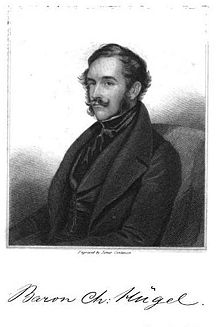Charles von Hügel
Appearance

Charles von Hügel (born Carl Alexander Anselm Baron von Hügel; 25 April 1795 – 2 June 1870), sometimes spelt in English Huegel, was an Austrian nobleman, army officer, diplomat, botanist, and explorer, now primarily remembered for his travels in northern India during the 1830s. During his lifetime he was celebrated by the European ruling classes for his botanical garden and his introduction of plants and flowers from New Holland (Australia) to Europe's public gardens.
| This article on an author is a stub. You can help out with Wikiquote by expanding it! |
Quotes
[edit]- It was adorned with many fine temples and monuments; among others, with a pillar cut out of one stone, twenty four yards high, at the top of which stood the image of Garuda, half-man and half-eagle.
- Charles von Hügel (1854), quoted in M. Jain, Flight of Deities and Rebirth of Temples (2019)
- The Surij Bagh is probably on the site of the once famous city of Parihasapur, of the marvels of which the native legends speak so highly. This city was built by the great conqueror Lalitaditya, who reigned from A.D. 714 to 750, and was adorned with many fine temples and monuments; among others, with a pillar cut out of one stone, twenty-four yards high, at the top of which stood the image of Garuda, half-man, half-eagle. Sikandar Budh Shikan probably destroyed it, but several fragments were seen in 1727 by Mohammed Azim. Immense images of gold, silver, and other metals, also adorned the interior, but all traces of this splendour have disappeared.
- Charles von Hügel, Travels In Kashmir And The Punjab, Languages Department, Punjab, first published 1844. Quoted from Jain, M. (editor) (2011). The India they saw: Foreign accounts. New Delhi: Ocean Books. Volume IV Chapter 9
- about the pillar at Surij Bagh [the Bagh was made by Surij Bahri, who was summoned to Kashmir by Moti Ram, the first viceroy under Ranjit Singh]

